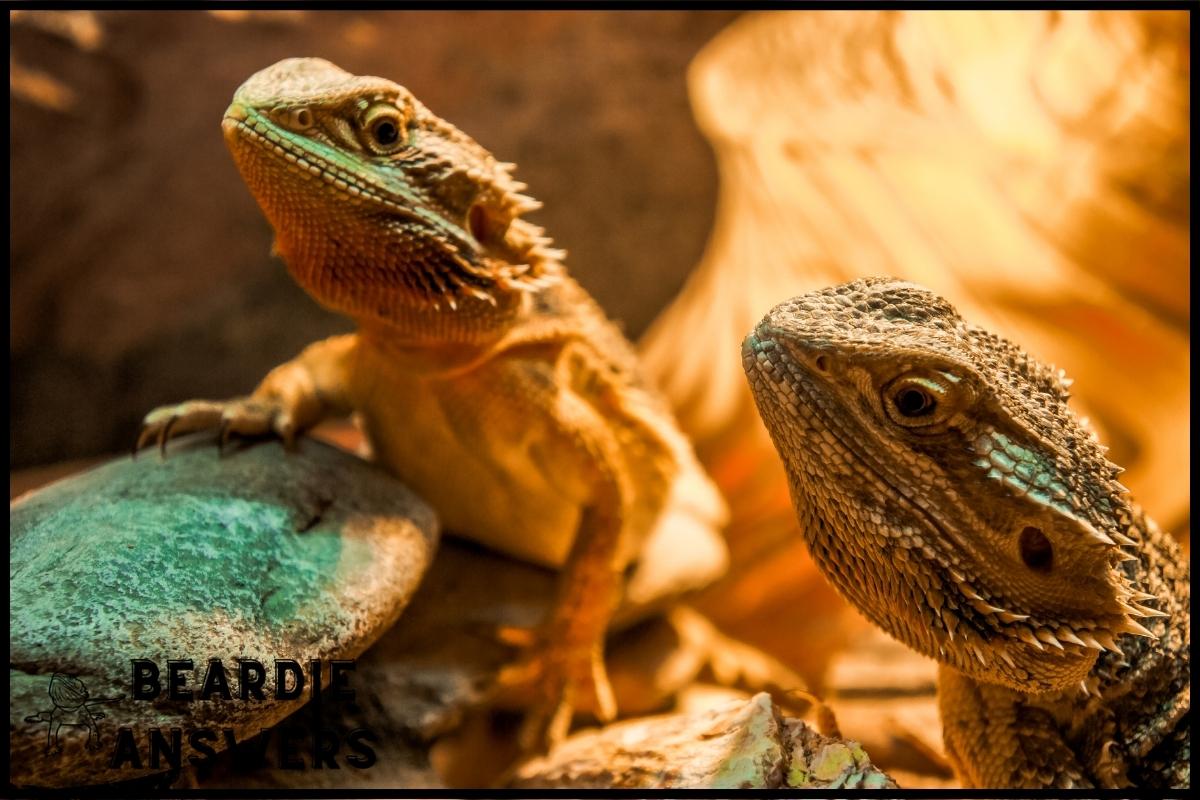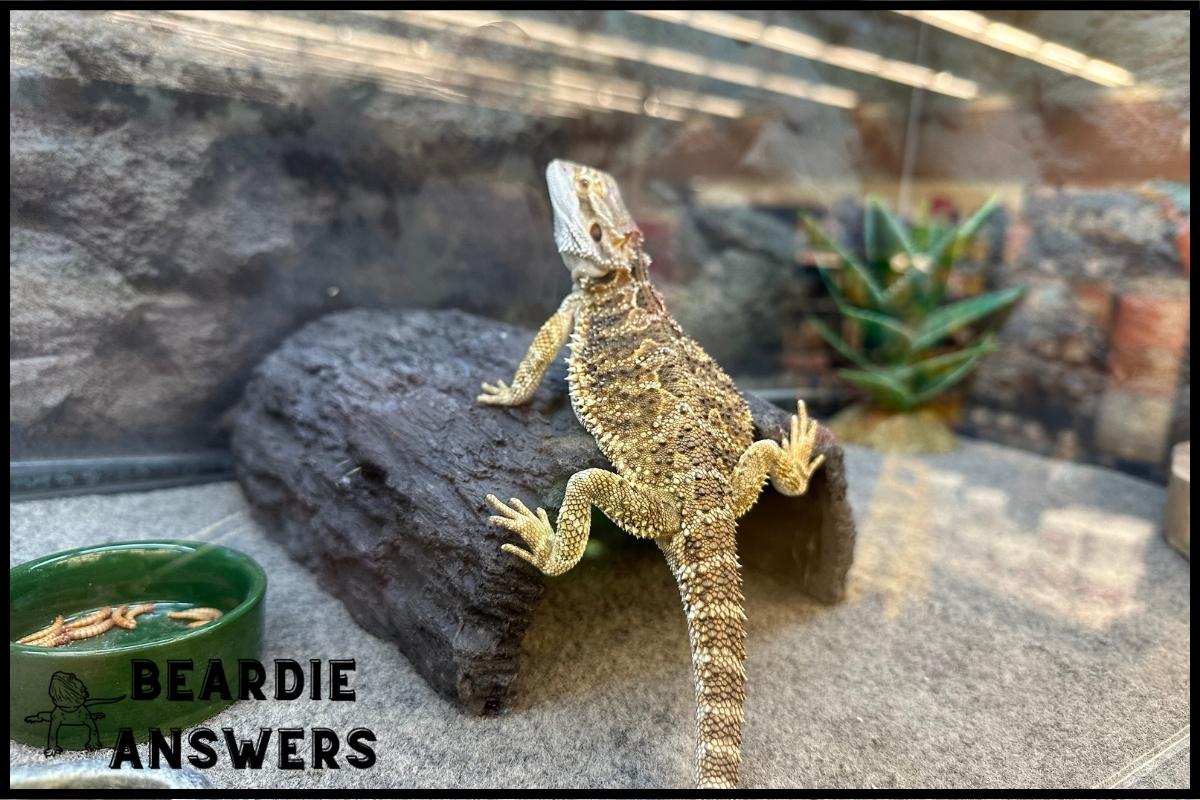Providing adequate living space is essential for the health and well-being of your bearded dragon. A tank that is too small can lead to stress and health problems. A 40-gallon tank is suitable for juvenile dragons, and a minimum of 75 gallons for adult dragons. Additionally, the enclosure should include appropriate lighting, heating, and substrate to create a comfortable and safe environment.
What You'll Learn
Understanding Healthy Bearded Dragon Behaviors
Bearded dragons are fascinating pets to own, and understanding their behaviors is key for providing the best care.
To ensure that your bearded dragon remains healthy, it’s important to understand how they handle stress and create an appropriate habitat for them.
Handling a bearded dragon correctly can help reduce stress levels, so use gentle motions when picking them up or moving them from one place to another.
When creating their habitat, make sure there is enough space for them to move around, as well as items like rocks and logs they may want to climb on or hide underneath.
Additionally, provide a UV light source and maintain temperatures between 75-88°F (24-31°C) during the day and 65-75°F (18-24°C) at night.
Understanding these behaviors will set you up for success in identifying any behavioral changes should your bearded dragon become sick.
Identifying Behavioral Changes In Your Bearded Dragon
It is important to understand healthy bearded dragon behaviors in order to identify when your pet may be sick. While most reptiles, including bearded dragons, are naturally inactive and spend much of their time sleeping or lounging, there are signs that they may not be feeling well.
Enrichment activities such as climbing and swimming can help keep them active, alert and engaged while also maintaining regular stress levels.
Behavioral changes in a normally active bearded dragon could indicate an underlying medical condition. Noticing any difference in behavior should prompt a visit to the veterinarian for further examination. Eating less than normal, refusing food entirely or drinking more water than usual are all red flags that something is wrong with your pet’s health. Changes in activity level or bowel movements might also signal illness.
In addition to these subtle behavioral changes, respiratory issues like wheezing or gasping for breath can indicate serious illness and require immediate veterinary attention. Lethargy is another common symptom which often signals infection or disease in bearded dragons; so it’s essential to recognize what constitutes normal activity versus lethargic behavior from your pet reptile—this will enable you to diagnose problems quickly if they arise.
With this knowledge, you’ll be able to take swift action if necessary and ensure your beloved beardie stays happy and healthy!
Transitioning into diagnosing lethargy in bearded dragons requires careful observation of your pet’s habits over time – starting now!
Diagnosing Lethargy In Bearded Dragons
Lethargy in bearded dragons can be like a storm cloud of despair, making it difficult to know what steps you should take next. It is important to monitor your dragon’s environment and behavior for any concerning signs that might indicate an underlying medical issue.
Here are some tips to keep at the forefront of your mind when diagnosing lethargy in bearded dragons:
Monitor Environment:
- Temperature – Measure temperature with thermometers and make sure their terrarium is adequately heated.
- Humidity – Use a hygrometer or humidity gauge to ensure humidity levels stay between 40-50%.
Seek Medical Help
If all else fails, reach out to a reptile vet or specialist who can help diagnose and treat any underlying issues causing the lethargy.
It goes without saying that examining your dragon’s appetite is also critical during this time. As you observe changes in eating habits, note them down as they could provide further insight into what may be going on with your pet.
Examining Your Bearded Dragon’s Appetite
When assessing your bearded dragon’s health, you should pay close attention to its appetite. Noting any changes in eating habits or weight loss can be an indicator of illness. If you notice that your bearded dragon is not eating as much, it may be necessary to modify the diet by adding supplements and changing up their meals more often. Consider speaking with a veterinarian if there are drastic changes in their diet or sudden sharp drops in weight.
It’s also important to monitor how they eat, rather than just what they’re consuming—are they being picky? Are some foods being refused altogether? These small details can make all the difference when trying to determine whether something is wrong. Similarly, check for physical signs like mouth sores or discoloration which could indicate underlying illnesses and warrant further investigation from a vet.
In addition, note how excited your beardie gets around meal time; if they seem disinterested or lethargic during feeding times then this could point towards them feeling under the weather. Keeping track of these behaviors can provide valuable insight into their overall well-being and inform decisions about seeking additional medical care.
Moving on to assess stool and respiratory issues will help paint a fuller picture of what might be going on with your pet reptile.
Assessing Stool And Respiratory Issues
You may be hesitant to assess the stool and respiratory issues of your bearded dragon, especially if you are a first-time owner. However, it is important to recognize these signs as early indicators of an illness. By understanding what to look for in terms of gut health and environmental stress, you can give them the care they need before their condition worsens.
When assessing your bearded dragon’s stool and respiratory issues, here are some points that should not go unnoticed:
Gut Health
- Check the color and consistency of their feces regularly
- Look out for any parasites or foreign objects in the feces
- Ensure that they have enough water intake due to dehydration being one cause of abnormal stools
Environmental Stress:
- Monitor temperature levels frequently to make sure it is within normal range (100°F – 110°F)
- Inspect surroundings such as UVB lighting fixtures, substrates, etc., for any irregularities
- Observe behavior patterns such as digging or scratching excessively which might indicate discomfort from environment
Being vigilant with recognizing changes in your pet’s health will help ensure that proper action can be taken if needed. It is also beneficial even if no symptoms arise; doing routine checkups can provide peace of mind knowing that your beloved reptile remains healthy and happy. With this knowledge in hand, let us move on to taking action when your bearded dragon is sick.
Taking Action When Your Bearded Dragon Is Sick
Now that you have assessed your bearded dragon’s stool and respiratory issues, it is important to know what actions to take when your pet appears ill. Monitoring temperature, seeking medical help if necessary, and providing the proper care can ensure your reptile friend stays healthy.
To begin, monitoring temperatures must be done regularly. Bearded dragons are from warm climates and therefore prefer a basking spot of 95-105°F (35-40°C). A cold or dry environment can lead to health problems such as metabolic bone disease or respiratory infections. It is important to check the temperature often in order to prevent these illnesses.
| Temperature Range | Action Required |
|---|---|
| Below 95°F (35°C) | Increase Temperature |
| Above 105°F (40°C) | Decrease Temperature |
It is also essential to seek help from a veterinarian if your bearded dragon continues to show signs of sickness. Your vet will be able to diagnose any underlying issues and provide advice on how best to treat them. Home remedies should only ever be used in moderation; always consult with an expert first before giving anything to your beloved pet!
Getting timely treatment for sick animals plays an integral role in their recovery process – so don’t hesitate when it comes time for professional assistance.
Taking good care of your bearded dragon doesn’t just involve regular feeding and cleaning – keeping close tabs on its behavior and overall wellbeing is equally important. If there’s something off about your scaly companion, act quickly by assessing its symptoms, taking appropriate measures based on temperature readings, and consulting experts if needed. Doing this could make all the difference between a happy ending for everyone involved!
Conclusion
It can be difficult to tell when your bearded dragon is sick, but by paying attention to signs of lethargy, lack of appetite, abnormal stool and respiratory issues you will have a better understanding.
Taking action quickly if any of these signs occur could mean the difference between life and death for your beloved pet.
Do not hesitate to contact an experienced veterinarian if you are unsure about your beardie’s health; they will provide the best advice on how to proceed in order to maintain their wellbeing.
Have you noticed any changes in your reptilian friend lately?

Hi! My name is Bryan, I am the “one behind the words” here are BeardieAnswers.com. I believe that providing quality care and nutrition is the best way to ensure the health of your pet. Every beardie is special and deserves the best care and attention. If you have questions about your bearded dragon, please don’t hesitate to ask! View My Full Author Page




